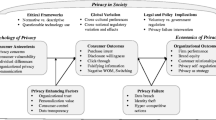Abstract
Recent critiques of the costs, effectiveness, and potential inequities in consumer protection measures have drawn attention to the need for a coherent normative framework for consumer protection. This paper sketches therefore a framework for government intervention in the marketplace to protect consumers' economic interests.
After outlining the overarching objectives of consumer protection, namely the improvement of economic efficiency and equity, it documents the two main failures in consumer markets, information and high enforcement costs. Discussion is then focused on the relevance of the recent “economics of information” literature and its implications in consumer protection. Finally, there is a brief discussion of equity rationales. The article concludes by drawing out the general policy implications of the approach adopted in the paper.
Zusammenfassung
Die neuere Kritik an den Kosten, an der Wirksamkeit und an den potentiellen Ungerechtigkeiten verbraucherpolitischer Instrumente macht deutlich, daß ein systematischer normativ-theoretischer Hintergrund für die Verbraucherpolitik nötig ist. Allgemeine Hinweise auf unausgewogene Marktmacht reichen im nach-regulatorischen Stadium nicht mehr aus.
Der vorliegende Beitrag umreißt daher einen Rahmen für staatliche Intervention auf M:arkten zum Schutz des Verbraucherinteresses. Zunächst werden die Verbesserung sowohl der ökonomischen Effizienz als auch der Gleichrangigkeit als die beiden Hauptziele der Verbraucherpolitik und ihre Beziehungen untereinander angesprochen. Es folgt eine Behandlung der Interventionsbegründungen unter dem Gesichtspunkt der Effizienz mit einer Diskussion der neueren Literatur zur Informationsökonomie in ihrer Bedeutung für die Identifizierung von Informationsunzulänglichkeiten zuf Konsumgütermärkten und eine Behandlung der Interventionsbegründungen unter dem Gesichtspunkt der Gleichrangigkeit.
Als Schlußfolgerung ergibt sich, daß Interventionen in höherem Maße markt- und produkt-spezifisch sein sollten; dies muß mit der Forderung nach längerfristiger Klarheit und Vorhersagbarkeit von Regelungen und Standards in Einklang gebracht werden. Abschließend wird darauf hingewiesen, daß trotz aller rationaler Rechtfertigungen, die der Beitrag liefert, die Entscheidung zur Intervention im Kern politischer Natur ist.
Similar content being viewed by others
References
Akerlof, G. (1970). The market for “lemons”: Qualitative uncertainty and the market mechanism. Quarterly Journal of Economics, 84, 488–500.
Barry, B. (1965). Political argument. Oxford: Oxford University Press.
Bator, F. (1958). The anatomy of market failure. Quarterly Journal of Economics, 72, 351–379.
Baumol, W., & Blinder, A. S. (1982). Economics: Principles and policy. New York: Harcourt Brace Jovanovich.
Beales, H., Craswell, R., & Salop, S. (1981). The efficient regulation of consumer information. Journal of Law and Economics, 24, 491–539.
Belobaba, E. (1983). Consumer product warranty reform: Regulation in search of rationality. Ottawa: Consumer and Corporate Affairs Canada.
Bourgoignie, T. (1984). The need to reformulate consumer protection policy. Journal of Consumer Policy, 7, 307–321.
Breyer, S. (1982). Regulation and its reform. Cambridge, MA: Harvard University Press.
Cave, M. (1985). Market models and consumer protection. Journal of Consumer Policy, 8, 335–351.
Cayne, D. J., & Trebilcock, M. J. (1973). Market considerations in the formulation of consumer protection policy. University of Toronto Law Journal, 23, 396–430.
C. B. I. (1979). Pilot study of the additional costs to the British consumer of compliance by industry with consumer legislation. London: Economist Intelligence Unit.
Coase, R. (1960). The problem of social cost. Journal of Law and Economics, 3, 1–44.
Dawson, J. (1976). Unconscionable coercion: The German version. Harvard Law Review, 89, 1041–1126.
Department of Trade and Industry (U.K.) (1985). Burdens on business. London: Her Majesty's Stationery Office.
Dewees, D. (1983). The regulation of quality: Products, services, workplaces, and the environment. Toronto: Butterworths.
Diver, C. S. (1983). The optimal precision of administrative rules. Yale Law Journal, 93, 65–109.
European Consumer Law Group (1983). Group actions in the consumer interest. Journal of Consumer Policy, 6, 325–350.
Federal Trade Commission (1979). Consumer information remedies. Washington, D.C.: Federal Trade Commission.
Goyens, M. (Ed.) (1985). E.C. competition policy and the consumer interest. Brussels: Cabay-Bruylant.
Handler, J. F. (1978). Social movements and the legal system. New York: Academic Press.
Jones, T. T., & Pickering, J. F. (1979). The consumer's interest in competition policy. I. Welfare implications. II. Policy implications. Journal of Consumer Studies and Home Economics, 3, 85–126.
Komesar, N. (1981). In search of a general approach to legal analysis: A comparative institutional alternative. Michigan Law Review, 79, 1350–1392.
Kronman, A. T. (1983). Paternalism and the law of contracts. Yale Law Journal, 92, 763–798.
Mishan, E. J. (1982). Cost-benefit analysis (3rd ed.). London: Allen & Unwin.
MIT (1978). Consumer durables: Warranties, service contracts, and alternatives. Cambridge, MA: Massachusetts Institute of Technology, Center for Policy Alternatives.
National Consumer Council (1980). Consumers and credit. London: National Consumer Council.
Nelson, P. (1970). Information and consumer behavior. Journal of Political Economy, 78, 311–329.
Nisbett, R. E., & Ross, L. (1980). Human inference: Strategies and shortcomings of social judgment. Englewood Cliffs, NJ: Prentice-Hall.
Nozick, R. (1974). Anarchy, state, and utopia. Oxford: Blackwell.
Office of Fair Trading (1982). Opticians and competition: A report by the Director General of Fair Trading on sections 21 and 25 of the Opticians Act 1958. London: Her Majesty's Stationery Office.
Pertschuk, M. (1982). Revolt against regulation: The rise and pause of the consumer movement. Berkeley: University of California Press.
Pitofsky, R. (1977). Beyond Nader: Consumer protection and the regulation of advertising. Harvard Law Review, 90, 661–701.
Priest, G. (1981). A theory of the consumer product warranty. Yale Law Journal, 90, 1297–1352.
Rakoff, T. (1982). Contracts of adhesion: An essay in reconstruction. Harvard Law Review, 96, 1174–1284.
Ramsay, I. (1981). Consumer redress mechanisms for defective and poor quality products. University of Toronto Law Journal, 31, 117–152.
Ramsay, I. (1984). Rationales for intervention in the consumer marketplace. London: Office of Fair Trading.
Rawls, J. (1971). A theory of justice. Cambridge, MA: Harvard University Press.
Reich, R. B. (1979). Towards a new consumer protection. University of Pennsylvania Law Review, 128, 1–40.
Royal Commission on Legal Services (1979). Final report. Cmnd. 7648. London: Her Majesty's Stationery Office.
Road Traffic Reports (1972). Robertson v. di Cicco, 431.
Scherer, F. (1980). Industrial market structure and economic performance (2nd ed.). Chicago. Rand McNally.
Schwartz, G., & Wilde, L. (1979). Intervening in markets on the basis of imperfect information: A legal and economic analysis. University of Pennsylvania Law Review, 127, 630–683.
Simon, H. (1975). Administrative behavior (3rd ed.). New York: Free Press.
Stigler, G. (1961). The economics of information. Journal of Political Economy, 69, 213–225.
Stigler, G. J. (1975). The citizen and the state. Chicago: University of Chicago Press.
Stone, C. (1976). Where the law ends: The social control of corporate behavior. New York: Harper & Row.
Stewart, R., & Sunstein, C. (1982). Public programs and private rights. Harvard Law Review, 95, 1195–1322.
Stuyck, J. (1983). Product differentiation: The legal situation. Deventer: Kluwer.
Sugden, R., & Williams, A. (1978). The principles of practical cost-benefit analysis. Oxford: Oxford University Press.
Swann, D. (1979). Competition and consumer protection. Harmondsworth: Penguin.
Teubner, G. (1983). Substantive and reflexive elements in modern law. Law and Society Review, 17, 239–285.
Trebilcock, M. (1976). Winners and losers in the modern regulatory state: Must the consumer always lose? Osgoode Hall Law Journal, 13, 619–647.
Trebilcock, M. J. (1980). The consumer interest and the regulatory process. In: A. J. Duggan & L. W. Darvall (Eds.), Consumer protection law and theory, pp. 257–269. Sydney: Law Book.
Trebilcock, M. J., Hartle, D. G., Prichard, I. J. S., & Dewees, D. N. (Eds.) (1982). The choice of governing instrument. Ottawa: Economic Council of Canada.
Unfair terms in contracts concluded with consumers (1984). Brussels: E.C. Supp. 1/84.
Veljanovski, C. G., & Whelan, C. (1983). Professional negligence and the quality of legal services: An economic perspective. Modern Law Review 46, 700–718.
Weisbrod, B. A., Handler, J. F., & Komesar, N. K. (1978). Public interest law: An economic and institutional analysis. Berkeley: University of California Press.
Whitford, W. (1973). The functions of disclosure legislation in consumer transactions. Wisconsin Law Review, 400–470.
Williams, F. (Ed.) (1977). Why the poor pay more, London: Macmillan.
Williamson, O. (1984). Corporate governance. Yale Law Journal, 93, 1197–1230.
Additional information
Iain Ramsay is a Lecturer at the Faculty of Law, University of Newcastle upon Tyne, 22–24 Windsor Terrace, Newcastle upon Tyne NE1 7RU, England. This article is a summary of ideas which are developed at greater length in I. Ramsay: Rationales for intervention in the consumer marketplace, Occasional Paper, Office of Fair Trading, London. Copies of this study may be obtained from the Office of Fair Trading.
Rights and permissions
About this article
Cite this article
Ramsay, I. Framework for regulation of the consumer marketplace. J Consum Policy 8, 353–372 (1985). https://doi.org/10.1007/BF00380247
Issue Date:
DOI: https://doi.org/10.1007/BF00380247




